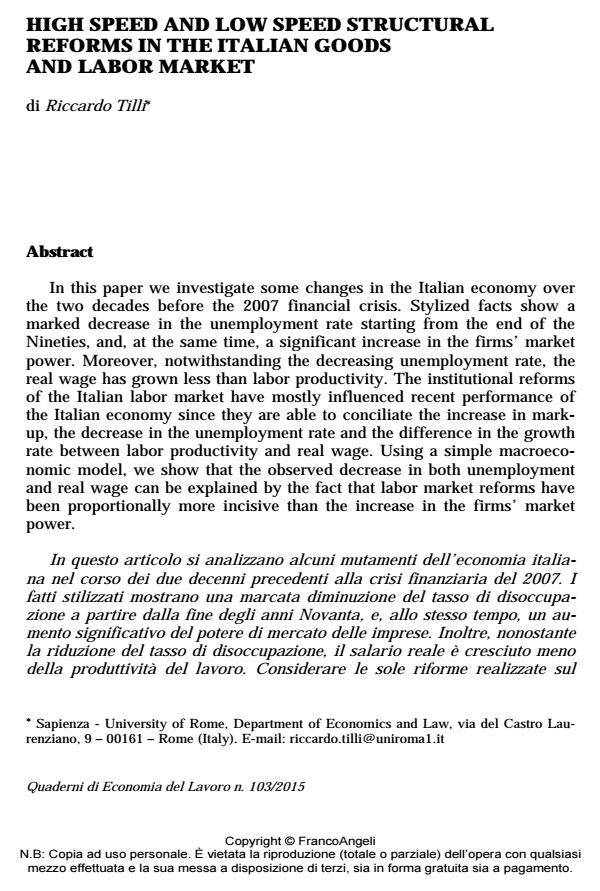High speed and low speed structural reforms in the italian goods and labor market
Titolo Rivista QUADERNI DI ECONOMIA DEL LAVORO
Autori/Curatori Riccardo Tilli
Anno di pubblicazione 2015 Fascicolo 2015/103 Lingua Italiano
Numero pagine 16 P. 67-82 Dimensione file 82 KB
DOI 10.3280/QUA2015-103005
Il DOI è il codice a barre della proprietà intellettuale: per saperne di più
clicca qui
Qui sotto puoi vedere in anteprima la prima pagina di questo articolo.
Se questo articolo ti interessa, lo puoi acquistare (e scaricare in formato pdf) seguendo le facili indicazioni per acquistare il download credit. Acquista Download Credits per scaricare questo Articolo in formato PDF

FrancoAngeli è membro della Publishers International Linking Association, Inc (PILA)associazione indipendente e non profit per facilitare (attraverso i servizi tecnologici implementati da CrossRef.org) l’accesso degli studiosi ai contenuti digitali nelle pubblicazioni professionali e scientifiche
In this paper we investigate some changes in the Italian economy over the two decades before the 2007 financial crisis. Stylized facts show a marked decrease in the unemployment rate starting from the end of the Nineties, and, at the same time, a significant increase in the firms’ market power. Moreover, notwithstanding the decreasing unemployment rate, the real wage has grown less than labor productivity. The institutional reforms of the Italian labor market have mostly influenced recent performance of the Italian economy since they are able to conciliate the increase in mark-up, the decrease in the unemployment rate and the difference in the growth rate between labor productivity and real wage. Using a simple macroeconomic model, we show that the observed decrease in both unemployment and real wage can be explained by the fact that labor market reforms have been proportionally more incisive than the increase in the firms’ market power.;
- Addessi W. and Busato F. (2009). Fair wages, labor relations and asset returns. Journal of Financial Stability, 5, 4: 410-430.
- Bentolila S. and Bertola G. (1990). Firing costs and labor demand: How bad is eurosclerosis? Review of Economic Studies, 57: 381-402.
- Blanchard O. J. (2000). Employment protection, sclerosis and the effect of shocks on unemployment. Lionel Robbins Lectures. London School of Economics.
- Blanchard O. J. and Giavazzi F. (2003). Macroeconomic effects of regulation and deregulation in goods and labor markets. The Quarterly Journal of Economics, 118, 3: 879-908.
- Blanchard O. J. and Portugal P. (2001). What hides behind an unemployment rate. comparing Portuguese and U.S. unemployment. American Economic Review, 91: 187-207.
- Danthine J. P. and Kurmann A. (2008). The macroeconomic consequences of reciprocity in labor relations. Scandinavian Journal of Economics, 109, 4: 857-881.
- Devicienti F., Maida A. and Pacelli L. (2008). The resurrection of the Italian wage curve. Economic Letters, 98: 335-41.
- Fella G. (2000). Investment in general training with consensual layoffs. Working Paper, 418. Queen Mary, University of London.
- Hopenhayn H. A. and Rogerson R. (1993). Job turnover and policy evaluation: a general equilibrium analysis. Journal of Political Economy, 101: 915–938.
- ISTAT (2007). Contabilità nazionale - Conti economici nazionali - Anni 1970-2005. Collana: Annuari, 10.
- ISTAT (2009). Contabilità nazionale - Conti economici nazionali - Anni 1996-2007. Collana: Annuari, 12.
- Koeniger W. (2002). Employment protection, product market competition and growth. IZA Discussion Papers, 554.
- Kuegler A. and Pica G. (2004). Effects of employment protection and product market regulations on the Italian labour market. CEPR Discussion Papers, 4216.
- Levine D. I. and Tyson L. D’A. (1990). Participation, productivity, and the firm’s environment. In: Alan Blinder, editor, Paying For Productivity. Washington, D.C.: The Brookings Institution.
- Mortensen D.T. and Pissarides C.A. (1994). Job creation and job destruction in the theory of unemployment. Review of Economic Studies, 61: 397–415.
- Mortensen D.T. and Pissarides C.A. (1999a). Job reallocation, employment fluctuations and unemployment differences. In: Taylor J. and Woodford M., editors, Handbook of Macroeconomics. Amsterdam: Elsevier, North Holland.
- Mortensen D.T. and Pissarides C.A. (1999b). New developments in models of search in the labor market. In: Ashenfelter O. and Card D., editors, Handbook of Labor Economics. Amsterdam: Elsevier, North Holland.
- OECD (1994). Employment Outlook 1994. Parigi: OECD.
- OECD (1999). Employment Outlook 1999. Parigi: OECD.
- Pissarides C.A. (2000). Equilibrium unemployment theory. Cambridge: MIT press.
- Saint-Paul G. (2002). Employment protection, international specialization, and innovation. European Economic Review, 46, 2: 375-395.
- Saltari E. and Tilli R. (2004). Labor market performance and flexibility: Which comes first? Topics on Macroeconomics, 4, 1, article 5. --Testo disponibile al sito: http://www.bepress.com/bejm/topics/vol4/iss1/art5.
- Saltari E. and Tilli R. (2011). Firing costs and labor market tightness: Is there any relationship? Research in Economics, 65: 1-4.
- Scialà A. and Tilli R. (2009). Financing unemployment benefits through fiscal policies and increasing competition. The ICFAI University Journal of Public Finance, 7, 1: 53-67.
Riccardo Tilli, High speed and low speed structural reforms in the italian goods and labor market in "QUADERNI DI ECONOMIA DEL LAVORO" 103/2015, pp 67-82, DOI: 10.3280/QUA2015-103005